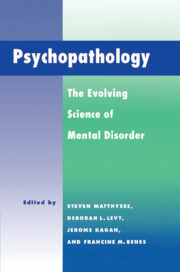Book contents
- Frontmatter
- Contents
- List of Contributors
- Preface
- Brain mechanisms
- Development
- Thinking
- Genetics
- 20 Editors' introduction: Contemporary issues in the genetics of psychopathological disorders
- 21 Genetic and environmental factors in the etiology of schizophrenia
- 22 Problems and paradoxes in research on the etiology of schizophrenia
- Comments on Einar Kringlen's chapter
- 23 Epistemological issues in psychiatric research
- 24 Searching for major genes for schizophrenia
- 25 The Drosophila eye and the genetics of schizophrenia
- Response and reflections
- Author index
- Subject index
25 - The Drosophila eye and the genetics of schizophrenia
Published online by Cambridge University Press: 04 May 2010
- Frontmatter
- Contents
- List of Contributors
- Preface
- Brain mechanisms
- Development
- Thinking
- Genetics
- 20 Editors' introduction: Contemporary issues in the genetics of psychopathological disorders
- 21 Genetic and environmental factors in the etiology of schizophrenia
- 22 Problems and paradoxes in research on the etiology of schizophrenia
- Comments on Einar Kringlen's chapter
- 23 Epistemological issues in psychiatric research
- 24 Searching for major genes for schizophrenia
- 25 The Drosophila eye and the genetics of schizophrenia
- Response and reflections
- Author index
- Subject index
Summary
Cognitive processing defects in schizophrenia
I would like to indulge in a little pole-vaulting across phyla, from Drosophila to schizophrenia. This familiar academic sport is usually played by the sellers of animal models, rather than the buyers; but as I work on schizophrenia and not on Drosophila, one unique feature of this exercise is that it will be from a buyer's point of view.
It seems to me (and many others) that schizophrenia is best understood as a failure of some aspects of what cognitive psychologists call automatic processing: the background of cognitive activity, carried out without awareness, that supports and facilitates conscious, effortful thought [32]. The existence of efficient cognitive preprocessing mechanisms is suggested by the ease and naturalness of thinking in normal people, despite the complex requirements thinking must meet to function competently. Our thought is able to navigate between Holzman's 20 categories of thought disorder [15, pp. 69-70]. Our memory can take advantage of context and predictability of word sequences, as Brendan Maher has observed (Chapter 19, this volume). Our language must conform to rules of syntax, semantics, logic and pragmatics. Nevertheless, ordinary thinking and speaking demand no special concentration and take hardly any time. We do not calculate before we speak, nor do we form our thoughts by a process of trial and error; we do not have to sift through a mixture of logical and illogical, grammatical and ungrammatical thoughts.
- Type
- Chapter
- Information
- PsychopathologyThe Evolving Science of Mental Disorder, pp. 557 - 580Publisher: Cambridge University PressPrint publication year: 1996
- 1
- Cited by



